Nerikiri making is a beloved Japanese tradition that captivates with its intricate artistry and delectable flavors. Crafting these delicate sweets involves an intricate process of kneading mochi-like dough, often infused with vibrant hues, to create whimsical flower shapes and designs. Filled with sweet red bean paste or seasonal ingredients, each nerikiri piece embodies the essence of nature and the changing seasons. Yet, the true allure of this meditative practice lies in the way it fosters a deep appreciation for the beauty and craftsmanship that elevates the humble sweet into a true work of art.
Key Points
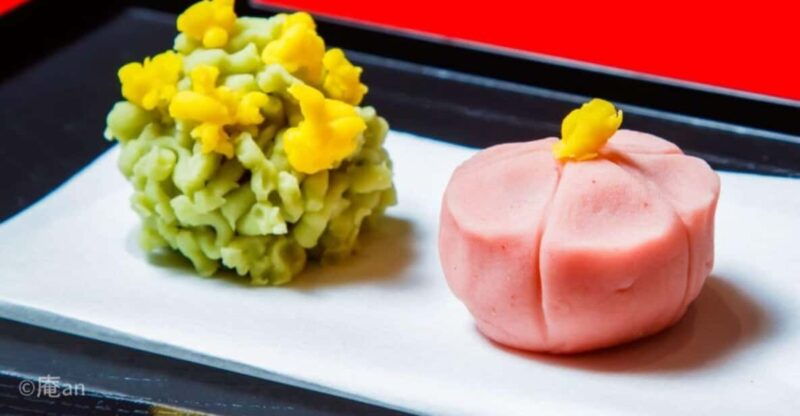
- Nerikiri are delicate Japanese traditional sweets made from mochi-like dough, often featuring intricate designs resembling flowers or natural elements.
- Nerikiri-making is a meditative practice that requires patience and skill, embodying the aesthetic of ‘wabi-sabi’ and representing the changing seasons and life’s fleeting nature.
- Skilled artisans knead and shape the mochi-like dough into captivating designs, using high-quality bean pastes and food coloring to create vibrant hues.
- In flower-shaped nerikiri making, participants select a color palette, knead and shape sweet white bean paste into delicate petals, and mold the center into a perfect bud.
- Kinton nerikiri features a vibrant yellow exterior made from sweet potatoes, encasing a luscious red bean paste filling, creating a harmonious balance of flavors.
Overview of Nerikiri
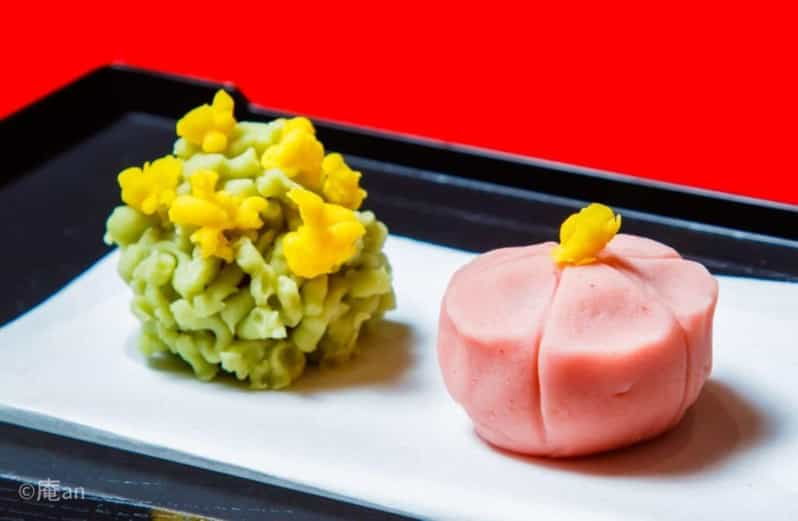
Nerikiri are delicate Japanese traditional sweets made from a specialized mochi-like dough and various fillings.
These confections are known for their intricate designs, often resembling flowers or other natural elements. The dough, made from glutinous rice flour, is kneaded to a smooth, pliable texture, then shaped and filled with sweet red bean paste or other seasonal fillings.
Nerikiri aren’t only visually stunning but also have a unique, subtly sweet flavor and a soft, delicate texture that melts in your mouth.
These delectable treats are a cherished part of Japanese confectionery culture.
Here are more experiences we've reviewed in Kyoto
Significance of Nerikiri in Japanese Culture
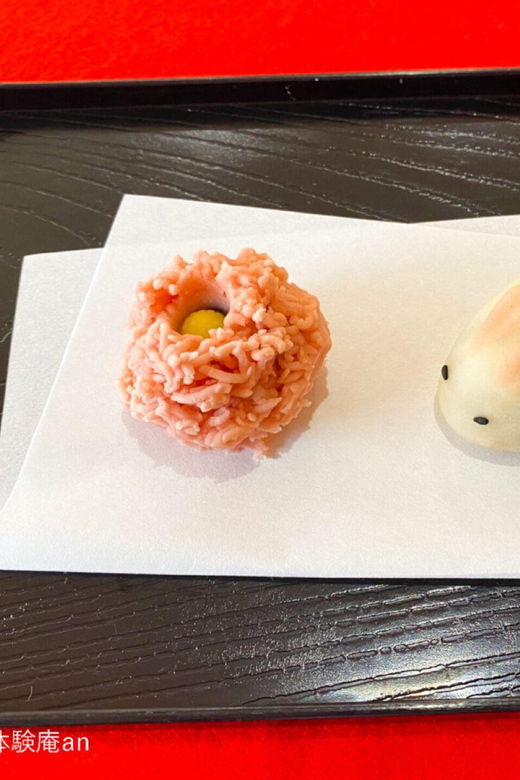
These delicate Japanese confections hold a profound significance within the country’s rich cultural heritage.
Nerikiri, with their intricate designs and ephemeral nature, embody the revered aesthetic of ‘wabi-sabi’ – the beauty in imperfection and transience.
The creation of Nerikiri is a meditative practice, requiring patience, skill, and an intuitive understanding of balance and form.
These sweets often depict natural motifs, serving as edible representations of the changing seasons and the fleeting nature of life itself.
The experience of Nerikiri-making encompasses:
- Honoring ancient traditions
- Appreciating the art of food preparation
- Connecting with the rhythms of nature
- Savoring the present moment
Ingredients and Preparation for Nerikiri
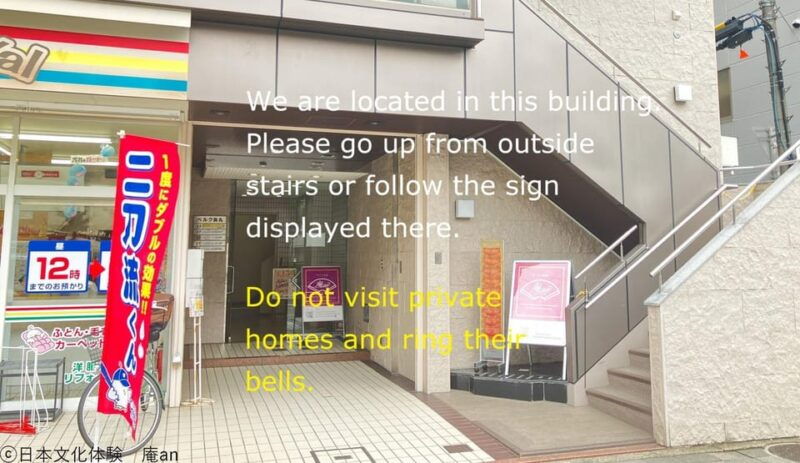
The creation of these delicate confections begins with carefully sourcing the finest ingredients. High-quality white and red bean pastes, meticulously crafted by Kyoto’s long-established shops, serve as the foundation.
Skilled artisans then knead and shape the mochi-like dough, known as nerikiri, into intricate floral designs and spherical kinton forms. The gentle application of food coloring transforms the pure white base into vibrant hues, capturing the essence of nature’s beauty.
With each delicate fold and precise cut, the sweets’ captivating aesthetics come to life, inviting participants to savor the exquisite flavors and textures of Japan’s traditional culinary artistry.
Flower-Shaped Nerikiri Making
Participants begin the flower-shaped nerikiri making process by carefully selecting a vibrant color palette from the assortment of food coloring provided.
Their nimble fingers knead and shape the sweet white bean paste into delicate petals. Shaping the center of the flower proves challenging, but they persevere, molding the paste into a perfect bud.
The experience evokes a sense of:
- Concentration as they meticulously craft each petal.
- Accomplishment when the flower takes shape.
- Appreciation for the beauty of traditional Japanese confections.
- Delight as they savor their handmade creation.
After the final touches, the flower-shaped nerikiri are ready to be enjoyed.
More Great Tours NearbyKinton Nerikiri Making
After mastering the delicate flower-shaped nerikiri, participants turn their attention to the Kinton nerikiri.
This variation features a vibrant yellow exterior made from mashed sweet potatoes, encasing a luscious red bean paste filling.
The instructors demonstrate the intricate process of kneading, shaping, and decorating the Kinton nerikiri.
Participants carefully follow along, forming their own bite-sized masterpieces.
The rich, earthy flavors of the sweet potato and adzuki bean create a harmonious balance, delighting the senses.
With a sense of accomplishment, participants eagerly await the opportunity to savor their handcrafted Kinton nerikiri.
- Kyoto: Kiyomizu-dera, Fushimi Inari & Gion Geisha District
- Kyoto: Visit Mario Papas Hometown and Great Lunch⭐️
- Kyoto: Arashiyama Bamboo Grove, Monkey Mountain Walking Tour
- From Kyoto/Osaka: Sagano Train Ride and Guided Day Tour
- Kyoto:Three Gardens Bike Tour
- Taste of Nishiki Market Walking Food Tour With Local Guide
Eating and Appreciating Nerikiri
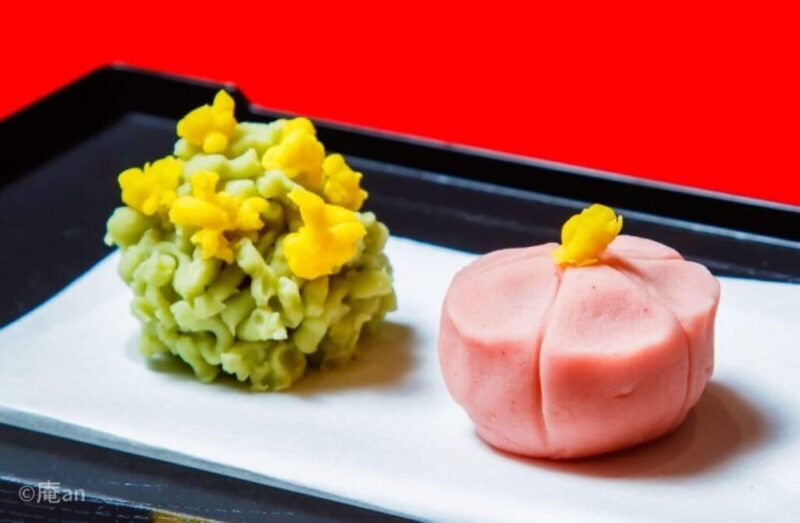
With their colorful and intricate nerikiri masterpieces finally complete, participants eagerly prepare to savor the fruits of their labor.
The delicate sweets glisten under the light, their vibrant hues captivating the senses. As they gently bite into the nerikiri, a symphony of flavors unfolds:
- The smooth, creamy texture of the bean paste melts on the tongue.
- The subtle sweetness is perfectly balanced, neither overpowering nor cloying.
- The intricate decorations add visual delight and a touch of whimsy.
- The sense of accomplishment and pride in creating these traditional confections fills the air.
Additional Options for the Experience
For those participants interested in enhancing their Nerikiri experience, the venue offers several optional add-ons. A sweets take-out box at 100 JPY allows guests to savor their creations later. An experience completion certificate at 300 JPY serves as a memento. Those who’d like to enjoy a traditional Tatedashi Matcha can do so for 500 JPY. Plus, a helper fee of 880 JPY is available for preschool children who require assistance. Children under 2 sitting on parents’ laps can participate for free.
| Option | Price |
|---|---|
| Sweets Take-out Box | 100 JPY |
| Experience Completion Certificate | 300 JPY |
| Tatedashi Matcha | 500 JPY |
| Helper Fee (for preschool children) | 880 JPY |
| Children under 2 (on parents’ laps) | Free |
Important Considerations for the Workshop
The venue’s operation hours are from 10:00 to 17:00, and reservations after 17:00 are processed the next day.
Participants should be aware that the workshop location has no elevator, and stairs are required to access the venues.
For those who need assistance, a helper fee of 880 JPY is available for preschool children.
The experience can be customized with the following options:
- Sweets take-out box for 100 JPY.
- Experience completion certificate for 300 JPY.
- Tatedashi Matcha for 500 JPY.
- English translation available upon request.
Non-participants aren’t allowed entry, and the cancellation policy applies, with fees incurred for changes after cancellation.
Things To Know
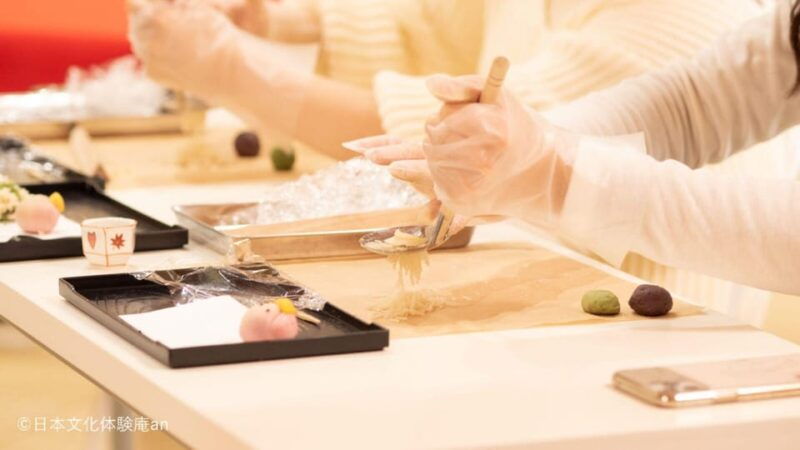
Can the Experience Be Customized for Dietary Restrictions?
The experience can be customized for dietary restrictions. Participants can contact the organizers in advance to discuss any special needs, and accommodations will be made to ensure everyone can enjoy the traditional sweets.
Are There Any Safety Precautions for Children During the Workshop?
For children, the workshop provides a dedicated "helper" fee to assist with preschoolers. And kids under 2 can attend for free, sitting on their parents’ laps. Safety is a top priority throughout the hands-on experience.
Is Prior Experience in Japanese Sweets-Making Required to Attend?
No prior experience in Japanese sweets-making is required to attend the workshop. It’s designed for beginners, providing a hands-on introduction to making traditional Nerikiri sweets. Just come with enthusiasm to learn and create!
Can Participants Take Photos or Videos During the Workshop?
Participants can take photos and videos during the workshop. The program schedule includes a dedicated "Picture time" slot, allowing guests to capture their handmade creations. No prior experience in Japanese sweets-making is required to attend.
Is There a Minimum or Maximum Group Size for the Experience?
The experience doesn’t mention a minimum or maximum group size. It’s likely participants can join individually or in small groups. You’d need to check availability and book accordingly to ensure your desired group size can be accommodated.
Sum Up
Nerikiri, the captivating Japanese confection, reflects the nation’s profound appreciation for artistry, culinary skill, and the fleeting beauty of nature. Through the meticulous shaping of vibrant mochi-like dough, each delicate treat embodies the essence of the changing seasons, inviting us to savor not just the flavors, but the very spirit of this centuries-old tradition.
You can check availability for your dates here:More Tours in Kyoto
- Full Day Tour of Kyoto with Private Transportation
- Matcha Grinding Experience and Walking Tour in Uji Kyoto
- Kyoto Hidden Treasures: Special Temple & Garden Access Tour
- Kyoto Uji and Nara Tour with Sushi Making Experience
- Kyoto Private Customizable Day Tour with Guide and Vehicle
- Himeji Castle and Akashi Kaikyo Bridge Walking Tour from Kyoto
More Tour Reviews in Kyoto
- Kyoto and Nara Private Trip
- Learn Japanese guitar “Shamisen”
- Kyoto Sushi & Takoyaki Cooking Class near Gion and Kiyomizu-dera!
- Kyoto and Nara Day Trip – Golden Pavilion and Todaiji from Osaka
- Full Day Tour of Kyoto with Private Transportation
- Explore Arashiyama Bamboo Forest with Authentic Zen Experience
Still browsing? Here are more Kyoto experiences we've covered recently
- Kyoto and Nara Private Trip
- Learn Japanese guitar “Shamisen”
- Kyoto Sushi & Takoyaki Cooking Class near Gion and Kiyomizu-dera!
- Kyoto and Nara Day Trip – Golden Pavilion and Todaiji from Osaka
- Full Day Tour of Kyoto with Private Transportation
- Explore Arashiyama Bamboo Forest with Authentic Zen Experience
- Matcha Grinding Experience and Walking Tour in Uji Kyoto
- Kyoto Hidden Treasures: Special Temple & Garden Access Tour
- Kyoto Uji and Nara Tour with Sushi Making Experience
- Kyoto Private Customizable Day Tour with Guide and Vehicle
- Himeji Castle and Akashi Kaikyo Bridge Walking Tour from Kyoto
- Full Day Kyoto Tour : Bamboo Forest, Golden Temple, Fushimi Inari
